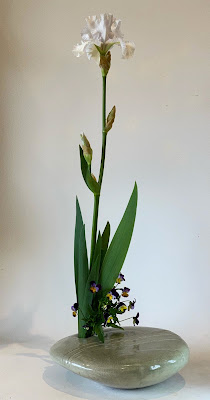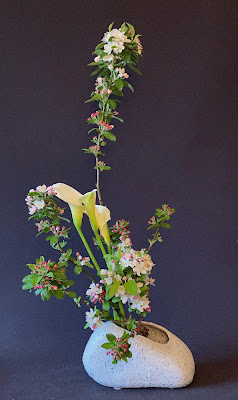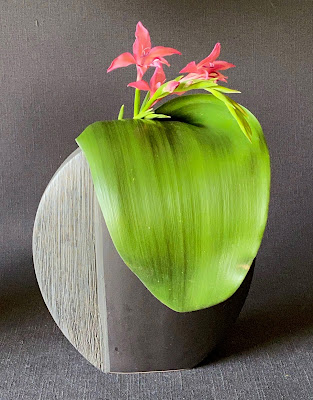 | |
|
We've had some unseasonably warm days recently, which accelerated the flowering of many plants in the garden. Not that I'm complaining!
I've been watching the progress of the flowering of the crabapple and, I think, I cut it at just the right time. I love it when some of the flowers are open while there are also tight, dark pink buds. In the arrangement, below, the front branches are coming forward, creating space for the arum lilies.
Last Wednesday I cut my first flag iris and promptly arranged it in the traditional way. With the warm weather, three more stems bloomed all together, necessitating a new and much bigger arrangement, also in the traditional style.
 |
| Flag iris and Japanese maple. There is a granite piece with rectangular hole placed over a suiban. |
 |
| Flag iris and violas in ceramic container. |
The new leaves on my smoke bush, Cotinus Grace, have a most beautiful russet colour, so I cut two stems, sacrificing future flowers, for this arrangement. Initially, I intended to use my yellow clivia with them. But, as is often the case in ikebana, my vision did not match the result. In such a situation, we have to be flexible. I had a double headed strelitzia, which I separated and positioned in place of the clivia. Both the colour and shape of the container complemented the material.
 |

The cherry blossoms in the next arrangement were 'rescued' from a straggling small and much neglected tree in our supermarket complex. The beauty of the blossoms is such that they require little else than to be displayed in an appropriate container. I just used some delicate flower buds from the nandina domestica to fill in some of the space.
While the leaves on my haemanthus plant are still green and lush, I wanted to use another one. Unlike some other leaves, like gymea, flax, aspidistra etc, these leaves don't last very well. I usually get about a week out of them before they become yellow. I made a very simple arrangement in a rather tall flat container and used with it my first cottage gladioli (or is it gladiolus?).
I went to the bottom of the garden to see if my white lilac was blooming, when I noticed that behind it, the clematis, which had no flowers the day before, had quite a few ready to be picked. This deciduous creeper is very easy to mistake for a dead twig in winter because its stem is dry and even splits and looks quite dead. That's what happened to my purple one and was removed when we had a new fence put in. I have to replace it.

Emily





No comments:
Post a Comment